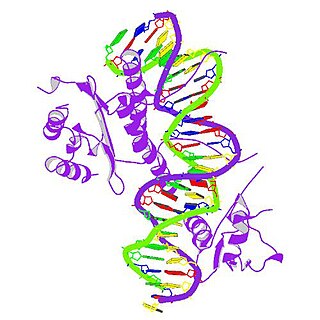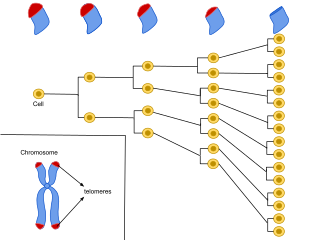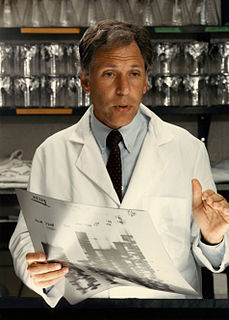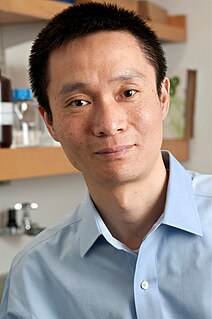Related Research Articles

Nicotinamide adenine dinucleotide (NAD) is a coenzyme central to metabolism. Found in all living cells, NAD is called a dinucleotide because it consists of two nucleotides joined through their phosphate groups. One nucleotide contains an adenine nucleobase and the other nicotinamide. NAD exists in two forms: an oxidized and reduced form, abbreviated as NAD+ and NADH (H for hydrogen), respectively.
Transfection is the process of deliberately introducing naked or purified nucleic acids into eukaryotic cells. It may also refer to other methods and cell types, although other terms are often preferred: "transformation" is typically used to describe non-viral DNA transfer in bacteria and non-animal eukaryotic cells, including plant cells. In animal cells, transfection is the preferred term as transformation is also used to refer to progression to a cancerous state (carcinogenesis) in these cells. Transduction is often used to describe virus-mediated gene transfer into eukaryotic cells.

Biogerontology is the sub-field of gerontology concerned with the biological aging process, its evolutionary origins, and potential means to intervene in the process. The term "biogerontology" was coined by S. Rattan, and came in regular use with the start of the journal BIOGERONTOLOGY in 2000. It involves interdisciplinary research on the causes, effects, and mechanisms of biological aging. Biogerontologist Leonard Hayflick has said that the natural average lifespan for a human is around 92 years and, if humans do not invent new approaches to treat aging, they will be stuck with this lifespan. James Vaupel has predicted that life expectancy in industrialized countries will reach 100 for children born after the year 2000. Many surveyed biogerontologists have predicted life expectancies of more than three centuries for people born after the year 2100. Other scientists, more controversially, suggest the possibility of unlimited lifespans for those currently living. For example, Aubrey de Grey offers the "tentative timeframe" that with adequate funding of research to develop interventions in aging such as strategies for engineered negligible senescence, "we have a 50/50 chance of developing technology within about 25 to 30 years from now that will, under reasonable assumptions about the rate of subsequent improvements in that technology, allow us to stop people from dying of aging at any age". The idea of this approach is to use presently available technology to extend lifespans of currently living humans long enough for future technological progress to resolve any remaining aging-related issues. This concept has been referred to as longevity escape velocity.
Anaplerotic reactions are chemical reactions that form intermediates of a metabolic pathway. Examples of such are found in the citric acid cycle. In normal function of this cycle for respiration, concentrations of TCA intermediates remain constant; however, many biosynthetic reactions also use these molecules as a substrate. Anaplerosis is the act of replenishing TCA cycle intermediates that have been extracted for biosynthesis.

Ronald T. Raines is an American chemical biologist. He is the Roger and Georges Firmenich Professor of Natural Products Chemistry at the Massachusetts Institute of Technology. He is known for using ideas and methods of physical organic chemistry to solve important problems in biology.

Serum response factor, also known as SRF, is a transcription factor protein.

Poliovirus receptor-related 1 (PVRL1), also known as nectin-1 and CD111 (formerly herpesvirus entry mediator C, HVEC) is a human protein of the immunoglobulin superfamily (IgSF), also considered a member of the nectins. It is a membrane protein with three extracellular immunoglobulin domains, a single transmembrane helix and a cytoplasmic tail. The protein can mediate Ca2+-independent cellular adhesion further characterizing it as IgSF cell adhesion molecule (IgSF CAM).

Regulatory-associated protein of mTOR also known as raptor or KIAA1303 is an adapter protein that is encoded in humans by the RPTOR gene. Two mRNAs from the gene have been identified that encode proteins of 1335 and 1177 amino acids long.

Prohibitin-2 is a protein that in humans is encoded by the PHB2 gene.

Dual specificity protein phosphatase 3 is an enzyme that in humans is encoded by the DUSP3 gene.

NUAK family SNF1-like kinase 1 also known as AMPK-related protein kinase 5 (ARK5) is an enzyme that in humans is encoded by the NUAK1 gene.

Cellular senescence is a phenomenon characterized by the cessation of cell division. In their experiments during the early 1960s, Leonard Hayflick and Paul Moorhead found that normal human fetal fibroblasts in culture reach a maximum of approximately 50 cell population doublings before becoming senescent. This process is known as "replicative senescence", or the Hayflick limit. Hayflick's discovery of mortal cells paved the path for the discovery and understanding of cellular aging molecular pathways. Cellular senescence can be initiated by a wide variety of stress inducing factors. These stress factors include both environmental and internal damaging events, abnormal cellular growth, oxidative stress, autophagy factors, among many other things.

Stuart A. Aaronson, M.D. is an American author and internationally recognized cancer biologist. He has authored more than 500 publications and holds over 50 patents, and was the Jane B. and Jack R. Aron Professor of Neoplastic Diseases and Chairman of Oncological Sciences at The Mount Sinai Hospital in New York City until March 2013, when he assumed the title of Founding Chair Emeritus of the Department of Oncological Sciences. The current Chairman of Oncological Sciences is Ramon E. Parsons.

Kinesin-5 is a molecular motor protein that is essential in mitosis. Kinesin-5 proteins are members of kinesin superfamily, which are nanomotors that move along microtubule tracks in the cell. Named from studies in the early days of discovery, it is also known as kinesin family member 11, encoded by the KIF11 gene, or as BimC, Eg5 or N-2, based on the founding members of this kinesin family. The term kinesin-5 has been recommended based on a standardized nomenclature adopted by the scientific community.

Photoactivatable probes, or caged probes, are cellular players that can be triggered by a flash of light. They are used in biological research to study processes in cells. The basic principle is to bring a photoactivatable agent to cells, tissues or even living animals and specifically control its activity by illumination.
DNA-SCARS are nuclear substructures with persistent DNA damage and DNA damage response proteins found in senescent cells. DNA-SCARS are associated with PML nuclear bodies and the accumulation of activated ATM, ATR, CHK2 and p53 proteins. DNA-SCARS lack most of the characteristics of transient, reversible DNA damage foci, such as single-stranded DNA, active DNA synthesis, and DNA repair proteins RPA and RAD51. Telomere dysfunction-induced foci (TIF) are generally associated with DNA-SCARS.

Chuan He is a Chinese-American chemical biologist, and is currently the John T. Wilson Distinguished Service Professor at the University of Chicago, and an Investigator of the Howard Hughes Medical Institute. He is best known for his work in discovering and deciphering reversible RNA methylation in post-transcriptional gene expression regulation.
Senotherapy is an early-stage basic research field for development of possible therapeutic agents and strategies to specifically target cellular senescence, an altered cell state associated with ageing and age-related diseases. The name derives from intent of the proposed anti-aging drug to halt "senescence". As of 2019, much of the research remains preliminary and there are no drugs approved for this purpose.

Diphosphoinositol pentakisphosphate kinase 2 is a protein that in humans is encoded by the PPIP5K2 gene.
Senescence-associated secretory phenotype (SASP) is a phenotype associated with senescent cells wherein those cells secrete high levels of inflammatory cytokines, immune modulators, growth factors, and proteases. SASP may also consist of exosomes and ectosomes containing enzymes, microRNA, DNA fragments, chemokines, and other bioactive factors. Initially, SASP is immunosuppressive and profibrotic, but progresses to become proinflammatory and fibrolytic. SASP is the primary cause of the detrimental effects of senescent cells.
References
- ↑ Won J, Kim M, Kim N, Ahn JH, Lee WG, Kim SS, Chang KY, Yi YW, Kim TK (July 2006). "Small molecule-based reversible reprogramming of cellular lifespan". Nat. Chem. Biol. 2 (7): 369–74. doi:10.1038/nchembio800. PMID 16767085. S2CID 85372472. (Retracted, see PMID 18560433)
- 1 2 Dennis Normile; Jennifer Couzin (March 5, 2008). "South Korean researcher suspended over charges of scientific misconduct". Science Now. Archived from the original on 2008-03-09. Retrieved 2008-03-17.
- ↑ Kenneth J. Moore (2008). "Data Duping". Chemical & Engineering News. Retrieved 2008-04-01.
- ↑ Bhattacharya S, Ray RM, Johnson LR (December 2008). "Role of polyamines in p53-dependent apoptosis of intestinal epithelial cells". Cell. Signal. 21 (4): 509–22. doi:10.1016/j.cellsig.2008.12.003. PMID 19136059.
- ↑ Crescenzi E, Palumbo G, de Boer J, Brady HJ (March 2008). "Ataxia telangiectasia mutated and p21CIP1 modulate cell survival of drug-induced senescent tumor cells: implications for chemotherapy". Clin. Cancer Res. 14 (6): 1877–87. doi: 10.1158/1078-0432.CCR-07-4298 . PMID 18347191.
- ↑ Sarah Everts (2006). "Aging Cells Get New Lease On Life - Small molecule is found to extend lifetime of mammalian cells". Chemical & Engineering News. Retrieved 2007-03-09.
- 1 2 Won J, Kim M, Kim N, et al. (July 2008). "Retraction: small molecule-based reversible reprogramming of cellular lifespan". Nat. Chem. Biol. 4 (7): 431. doi: 10.1038/nchembio0708-431 . PMID 18560433.